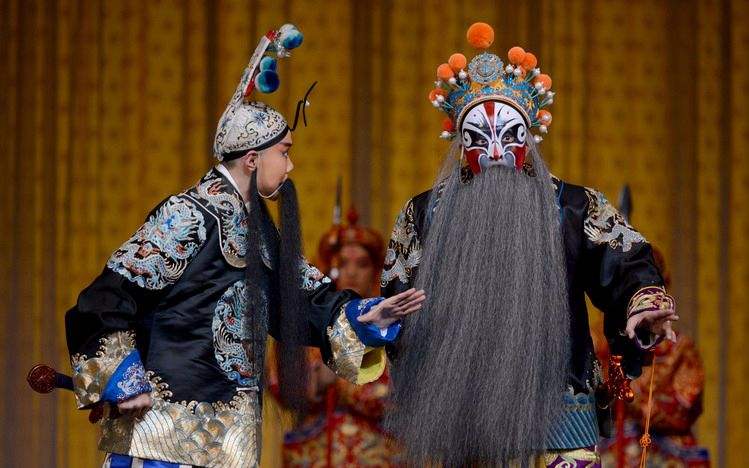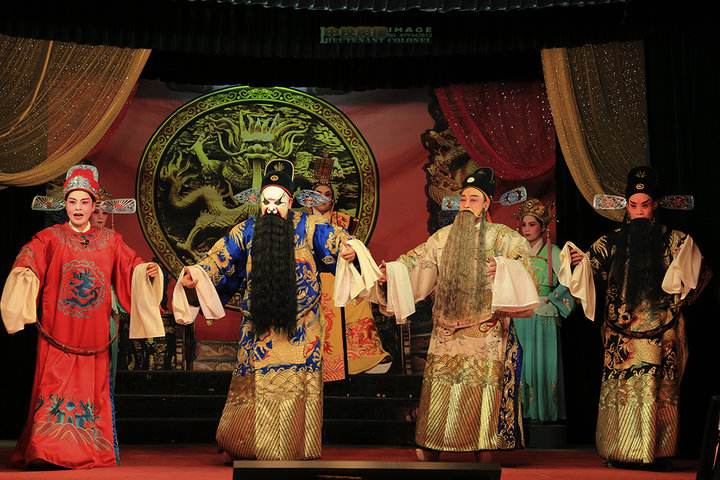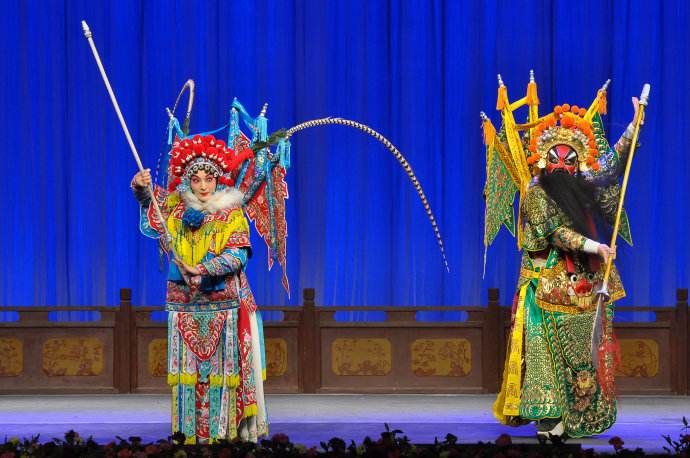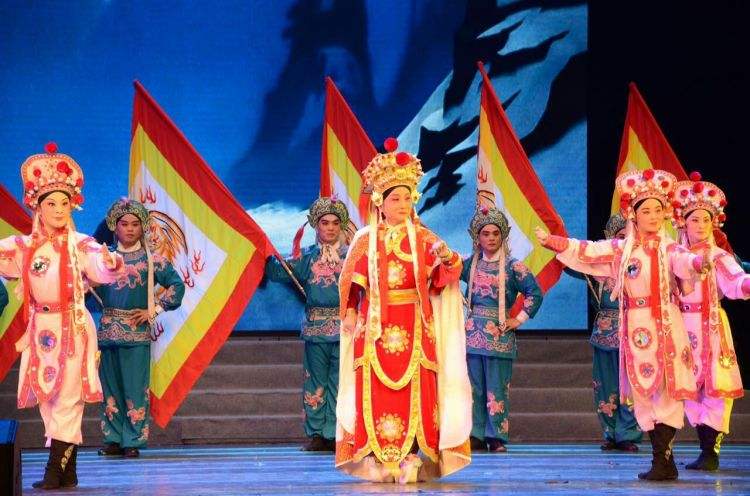Four Skills and Accompaniment
6 min readThanks to a long history of evolvement,traditional opera has developed a complete artistic form consisting of unique elements.A Chinese proverb says”while a layman stays and watches for fun,a connoisseur understands and appreciates theessence.”A knowledge of the essence of traditional opera,including”four skills’(singing,reciting,dance-acting and combating),accompaniment,different roles,facial make-up and costumes as well as,is a gateway to understanding of the unique art.
Four Skills and Accompaniment
1)Singing,Reciting,Dance-acting and Combating Singing,reciting,dance-acting and combating are termed as”four skills”,which is the primary standard to measure performing level of an actor.

Singing is to sing songs which take various forms,including solo,antiphonal singing,chorus and backstage accompaniment singing.It is so important in traditional opera that Chinese people always refer to operatic performance as “singing a play”.Thus a real fan often goes to theatre of traditional opera to enjoy a play through listening rather than watching.And while a child wants to sit at a master’s feet to learn traditional opera,a good voice is necessary.Unlike their counterparts in European opera who need to sing throughout the play,performers of traditional opera sing occasionally,usually at the time when the character wants to unleash his or her feelings,often sad,resentful,anxious or bitter,though all kinds of emotions,either joyous or gloomy,could be expressed through singing.The basic requirement for the singing of traditional opera is zi zheng qiang yuan,meaning that the written characters(zi)should be delivered accurately and precisely,and the melodic passages or tunes(qiang)should be weaving,or”round”.Characters and tunes could be combined in two ways:less characters packed into a long melodic passage v.s.more characters packed into a short one.The former is often applied when a role is filled with emotions while the latter is used for stating or pouring out a character’s heart.The song words usually are poetic lines,making the songs extraordinarily lyric.

“Reciting”,spoken part of traditional opera,is to recite lines.Similar to daily language as they are,reciting is by no means an easy job,as is reflected by the popular saying”Recitation is worth a kilo of gold while the song is only worth two hundred grams of gold”.Recitations must be delivered clearly,precisely and in a rhythmical fashion.In some traditional operas,recitations fall into two categories:rhythmical speech and prose speech.Quite different from daily language in pronunciation,the former is used by characters of higher status,while thelatter,which is delivered with vernacular,is used by those from lower-class.
Dance-acting refers to various facial expressions and body gestures employed by performers to externalize the inner world of the characters.it has five basic expression skills,namely hand skill,eye skill,body skill,hair skill and stride skill.

Hand skill is a term used not only for various gestures made with fingers,the palm and arms,such as the”orchid-like finger”,”tiger-like finger”,”monkey-like finger”,”willow-leaf-like hand”and”yin-yang palm”,but also for a variety of actions made with a fan,a handkerchief,or a whip,which are regarded as an extension of hands and could be used in diverse manners.
Eye skill refers to various expressions in a performer’s eyes.A fan of traditional opera knows well that”excellent performance depends on facial xpressions which in turn depend on expressions in eyes”. Performers use various eye skills such as glancing sideways, looking into distance, staring or looking flirtatiously, to express emotions such as joy, anger, sadness, scare, worry and dizziness. In performing the body gestures shall follow the changes of eye skill, just as the saying goes “The eyes are the leader of the body, the movement of the latter should respond to the former.
Body skill is a general term for varied postures made mainly with the waist, together with the limbs and the neck, to symbolize such actions as “sit”,”lie”,”stand”,”walk”, etc. With costumes swaying as the body moves, it is highly imaginative.
Hair skill refers to actions made by a performer with either his hair or his headdress, such as hat wings (two wing-like parts stretching from the back of gauze hat worn by characters in traditional opera) and the long pheasant feather tails(usually two pieces worn on a warrior’s helmet in traditional opera). There are various ways for a performer to play with his headdress so as to indicate a character’s complex inner feelings. For instance, hat wings are shaken either front to back or up and down. In the case of the pheasant feather tails, performers may choose to shake one at a time, or two at a time.
Stride skill refers to stage walk which varies from character to character.A civil official’s walk, which is called “square walk”, should be steady and has an air of dignity;a military official’s walk, on the other hand, should remind people of the valor and vigor displayed by a dragon or tiger and thus be imposing; an old man should stagger;a drunken man should walk unevenly;a lady shouldn’t sway her dress or skirt too much while walking and a maid should walk quickly and quietly. Inaddition, there are also some special forms of stage walk used on special occasions, such as “walking in circles”or “walking along the verge”.
“Combating”refers to various martial or acrobatic skills, used to indicate fighting in most cases, and riding a horse or jumping over a trench on some occasions. There are two kinds of combating:”combating with sword and spear”and”combating on the floor”. The former includes duel or solo dance while the latter refers to the diverse somersaults made by performers. Combating in traditional opera is not a real grapple. In order to attract the audience, performers must perform a variety of dazzling and difficult acts to accentuate characters’ inner world.
2) Accompaniment
The impressive musical effect of traditional opera should be attributed to not only its rhythmical songs and recitations but also the musical accompaniment whichhelps the audience better understand characters’ feelings on the one hand and lends color to the stage on the other. Musical instruments used on the stage vary from one genre of traditional opera to another, but every genre has its own primary instrument, such as qudi(lute produced in Suzhou, Jiangsu province) in kunqu, banhu(fiddle,a traditional Chinese music instrument) in qinqiang, yuju and Hebei bangzi.
What kind of instrument is the primary one often become an important basis to distinguish one genre from another.
Generally speaking, music instruments in traditional opera can be classified into two kinds: strings and percussion. Jinghu (a small high pitched two string fiddle), Peking opera erhu(two-stringed bowed instrument with a lower register than jinghu), dizi(Chinese bamboo lute), suona horn (a Chinese brass trumpet-like windinstrument), yueqin (a circular bodied plucked lute), xiaosanxian (a small three-stringed plucked instrument) are examples of the first kind while daluo(a big gong), xiaoluo(a small gong), tanggu (a barrel-shaped drum), danpi gu(a small drum used t beat the time for other instruments to achieve unison), paiban (a clapper), and naobo(a cymba1) all belong to the second kind.A scene accompanied by strings iscalled”wenchang”(a civil scene) while a scene accompanied by the second kind is called”wuchang”(a military scene).

These two genres of instrument are used for different purposes. Strings are used for accompanying performers’ songs and recitations, for exaggerating the stage atmosphere, for prelude and intervals between sentences, for receiving and seeing off guests and for deploying troops. Percussion are used to keep the tempo, just fo this reason Fans of traditional opera always compare gongs and drums to the joints of a human body. Percussion instruments are used when a performer sings or speaks, but they are mostly frequently used when a performer acts. What’s more, the way t beat the gongs and drums varies according to different situations. For instance,a general is usually accompanied by a big gong and big drum while a maid by a small gong with a crisp rhythm.








